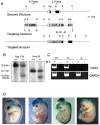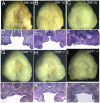Cleft palate is caused by CNS dysfunction in Gad1 and Viaat knockout mice
- PMID: 20333300
- PMCID: PMC2841638
- DOI: 10.1371/journal.pone.0009758
Cleft palate is caused by CNS dysfunction in Gad1 and Viaat knockout mice
Abstract
Background: Previous studies have shown that disruption of GABA signaling in mice via mutations in the Gad1, Gabrb3 or Viaat genes leads to the development of non-neural developmental defects such as cleft palate. Studies of the Gabrb3 and Gad1 mutant mice have suggested that GABA function could be required either in the central nervous system or in the palate itself for normal palatogenesis.
Methodology/principal findings: To further examine the role of GABA signaling in palatogenesis we used three independent experimental approaches to test whether Gad1 or Viaat function is required in the fetal CNS for normal palate development. We used oral explant cultures to demonstrate that the Gad1 and Viaat mutant palates were able to undergo palatogenesis in culture, suggesting that there is no defect in the palate tissue itself in these mice. In a second series of experiments we found that the GABA(A) receptor agonist muscimol could rescue the cleft palate phenotype in Gad1 and Viaat mutant embryos. This suggested that normal multimeric GABA(A) receptors in the CNS were necessary for normal palatogenesis. In addition, we showed that CNS-specific inactivation of Gad1 was sufficient to disrupt palate development.
Conclusions/significance: Our results are consistent with a role for Gad1 and Viaat in the central nervous system for normal development of the palate. We suggest that the alterations in GABA signaling lead to non-neural defects such as cleft palate as a secondary effect due to alterations in or elimination of fetal movements.
Conflict of interest statement
Figures






Similar articles
-
Nonneuronal expression of the GABA(A) beta3 subunit gene is required for normal palate development in mice.Dev Biol. 2003 Feb 1;254(1):93-101. doi: 10.1016/s0012-1606(02)00030-1. Dev Biol. 2003. PMID: 12606284
-
Cleft palate in mice with a targeted mutation in the gamma-aminobutyric acid-producing enzyme glutamic acid decarboxylase 67.Proc Natl Acad Sci U S A. 1997 Oct 14;94(21):11451-5. doi: 10.1073/pnas.94.21.11451. Proc Natl Acad Sci U S A. 1997. PMID: 9326630 Free PMC article.
-
Deletion of the T-box transcription factor gene, Tbx1, in mice induces differential expression of genes associated with cleft palate in humans.Arch Oral Biol. 2018 Nov;95:149-155. doi: 10.1016/j.archoralbio.2018.08.001. Epub 2018 Aug 9. Arch Oral Biol. 2018. PMID: 30121012
-
Genes and microRNAs associated with mouse cleft palate: A systematic review and bioinformatics analysis.Mech Dev. 2018 Apr;150:21-27. doi: 10.1016/j.mod.2018.02.003. Epub 2018 Feb 21. Mech Dev. 2018. PMID: 29475039 Free PMC article.
-
Palatogenesis: engineering, pathways and pathologies.Organogenesis. 2011 Oct-Dec;7(4):242-54. doi: 10.4161/org.7.4.17926. Epub 2011 Oct 1. Organogenesis. 2011. PMID: 21964245 Free PMC article. Review.
Cited by
-
GABAergic neurons regulate lateral ventricular development via transcription factor Pax5.Genesis. 2013 Apr;51(4):234-45. doi: 10.1002/dvg.22370. Epub 2013 Feb 25. Genesis. 2013. PMID: 23349049 Free PMC article.
-
Early-infantile onset epilepsy and developmental delay caused by bi-allelic GAD1 variants.Brain. 2020 Aug 1;143(8):2388-2397. doi: 10.1093/brain/awaa178. Brain. 2020. PMID: 32705143 Free PMC article.
-
Ultra-Rare Variants Identify Biological Pathways and Candidate Genes in the Pathobiology of Non-Syndromic Cleft Palate Only.Biomolecules. 2023 Jan 26;13(2):236. doi: 10.3390/biom13020236. Biomolecules. 2023. PMID: 36830605 Free PMC article.
-
Amino acid metabolism and autophagy in skeletal development and homeostasis.Bone. 2021 May;146:115881. doi: 10.1016/j.bone.2021.115881. Epub 2021 Feb 10. Bone. 2021. PMID: 33578033 Free PMC article. Review.
-
Bi-allelic GAD1 variants cause a neonatal onset syndromic developmental and epileptic encephalopathy.Brain. 2020 May 1;143(5):1447-1461. doi: 10.1093/brain/awaa085. Brain. 2020. PMID: 32282878 Free PMC article.
References
-
- Culiat CT, Stubbs LJ, Woychik RP, Russell LB, Johnson DK, et al. Deficiency of the beta 3 subunit of the type A gamma-aminobutyric acid receptor causes cleft palate in mice. Nat Genet. 1995;11:344–346. - PubMed
-
- Wojcik SM, Katsurabayashi S, Guillemin I, Friauf E, Rosenmund C, et al. A shared vesicular carrier allows synaptic corelease of GABA and glycine. Neuron. 2006;50:575–587. - PubMed
Publication types
MeSH terms
Substances
Grants and funding
LinkOut - more resources
Full Text Sources
Medical
Molecular Biology Databases
Research Materials

